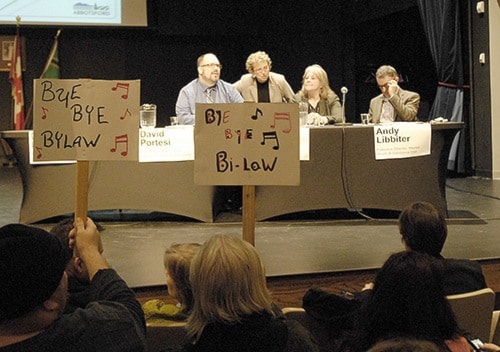The debate on a bylaw banning harm reduction measures in Abbotsford continues to divide the public, with residents expressing both support and concerns at the second of two public forums.
The second forum was held Tuesday evening, hosting a four-person panel of representatives from Fraser Health, who spoke about their proposed plan for harm reduction in the city and their determination to see the bylaw repealed.
Currently, the City of Abbotsford is reviewing its 2005 zoning bylaw that prohibits harm reduction measures, including needle exchanges, from occurring in the city.
David Portesi, the interim executive director of clinical programs and operations at Fraser Health, spoke on the panel, saying Fraser Health’s stance on the issue is simple.
“We would like the bylaw to not be in existence.”
He said Fraser Health would like to work with the city as much as possible, but if they decide not to remove the bylaw, Fraser Health has already begun to explore legal solutions, on the basis that it is not within municipalities’ rights to set the standard of health care.
Harm reduction refers to public health policies designed to reduce harmful consequences and is usually associated with needle exchange programs, free condoms, safe injection sites and other services that help drug users, prostitutes and other at-risk individuals.
The two public forums were held at the Matsqui Centennial Auditorium and each drew about 150 people, with about half attending both panel discussions.
The first panel, on Jan. 22, hosted representatives from four local service providers – The Women’s Resource Centre of the Fraser Valley/Warm Zone, Kinghaven Peardonville House Treatment Centres, Life Recovery and the Salvation Army.
The audience input at these forum was mixed, with some expressing support for harm reduction measures in Abbotsford, while others expressed desire to find other solutions.
In 2010, Fraser Health asked the city to take a second look at the bylaw, due to evidence that needle exchanges could help lower cases of Hepatitis C, caused by using dirty needles.
Fraser Health’s presentation outlined a proposed a plan for harm reduction in Abbotsford based on the B.C. Centre for Disease Control’s best practices, and called for the establishment of an Abbotsford harm reduction community advisory board.
“From the highest levels of provincial government we are getting a push to institutionalize harm reduction,” said Portesi.
The speakers, including Dr. Marcus Lem, medical health officer for Fraser Health’s east region, Sherry Mumford, the director of clinical programs, and Andy Libbiter, executive director of mental health and substance use, all acknowledged the complexity of harm reduction measures. The presentations given by the panel explained that it requires more than needle exchange programs. They called for community engagement, user empowerment, referral to services, access to primary care, mental health resources and more.
Tim Williams, chairman of the LIFE Recovery Association, questioned the panel, saying he read the reports used by Fraser Health to guide their policy and questioned the proof that harm reduction is effective in reducing disease.
“I’m trying my hardest to find reliable scientific data and all of the ones with the largest sample sizes… in North America are all saying there is not an association or a link between needle exchange programs and a reduction in HIV or Hepatitis C.”
Dr. Lem said the data presented that supported harm reduction measures is from B.C., and chosen because it is more applicable to this population. He said studies often draw different conclusions but the ones chosen were picked for their methodological rigour.
Brian Gross, executive director for Impact Youth Substance Use Services, spoke to the panel, reinforcing that “there are no facts when it comes to research, but there is evidence.” He said there is evidence that harm reduction measures in Abbotsford are connecting people with treatment, and work towards this goal, despite the bylaw, is admirable. He said without the bylaw, services like Impact would do “even better.”
City council will begin to review information from panelists and public comment.
